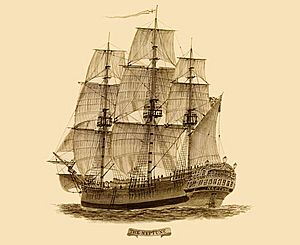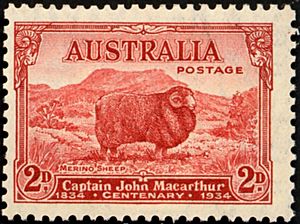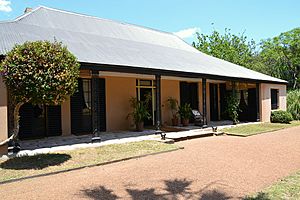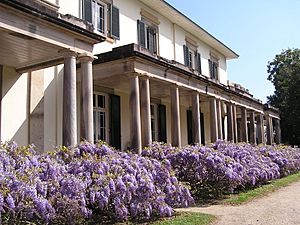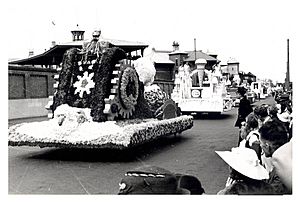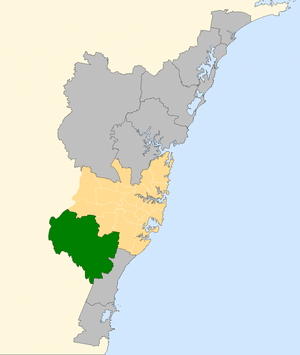John Macarthur facts for kids
Quick facts for kids
John Macarthur
|
|
|---|---|
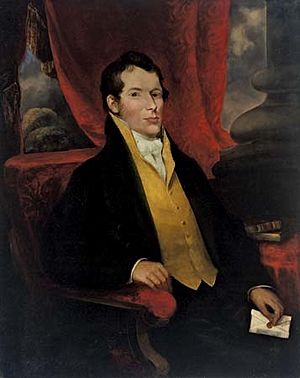
An oil painting of John Macarthur, the original of which is in the Dixson Galleries collection, State Library of New South Wales
|
|
| Born | 1767 near Plymouth, England
|
| Died | 1834 (aged 66–67) Camden, New South Wales, Australia
|
| Other names |
|
| Occupation | Army officer; colonial administrator; entrepreneur, politician, architect and pioneer pastoralist |
| Known for | Pioneer of Australia's wool and wine industries |
|
Notable work
|
|
| Spouse(s) |
Elizabeth Macarthur
(m. 1788; his death 1834) |
| Children | 8; including:
|
| Military career | |
| Allegiance | British army |
| Years of service | 1782—c. 1805 |
| Rank | Captain |
| Unit | New South Wales Corps |
| Agitator in the | Rum Rebellion |
| Member of the New South Wales Legislative Council | |
| In office 17 July 1825 – 31 December 1832 |
|
John Macarthur (1767 – 10 April 1834) was an important British army officer, businessman, and politician. He was a pioneer in the early settlement of Australia. Macarthur is famous for starting Australia's successful wool industry in the early 1800s. This industry later became a key part of the nation's identity. He also designed Elizabeth Farm House, his home in Parramatta. He also hired John Verge to design Camden Park Estate in Camden, New South Wales.
Contents
Early Life of John Macarthur
John Macarthur was born in 1767 near Plymouth, England. His father, Alexander Macarthur, had lived in the West Indies before. He returned to England and worked as a linen draper.
For most of his life, John spelled his last name "M'Arthur" or "MacArthur". The spelling "Macarthur" (with a small "a") became common only later in his life.
John Macarthur's Family Life
John Macarthur married Elizabeth Macarthur in October 1788. They sailed to the new colony of New South Wales after John joined the New South Wales Corps in 1789. Sadly, their first daughter was born during the voyage but did not survive.
John and Elizabeth had four sons who grew up: John, Edward, James (born 1798), and William (born 1800). James and William were born at Elizabeth Farm.
John Macarthur's Military Career
In 1789, John Macarthur became an ensign in Fish's Corps. This was a British Army regiment formed for the American Revolutionary War. However, the war ended before the regiment was ready, and it was disbanded in 1783. Macarthur then lived on a farm in Devon, England. He became interested in farming and learned a lot about it.
In 1788, Macarthur returned to full-time army duties. He joined the 68th Regiment of Foot. Later, he was posted to far-away Sydney with the New South Wales Corps in 1789. He sailed on the ship Neptune as part of the Second Fleet. This fleet was known for its difficult journey.
He arrived in Sydney in 1790 as a lieutenant. He was appointed as the commander at Parramatta. In 1793, the acting governor, Major Francis Grose, gave Macarthur 100 acres (about 0.4 square kilometers) of land near Parramatta. He received another 100 acres in 1794. This was because he was the first person to clear and farm 50 acres (about 200,000 square meters) of land. He named this property Elizabeth Farm, after his wife.
Grose relied on Macarthur's skills. He made him paymaster for the regiment and superintendent of public works. But Macarthur resigned in 1796 to focus on his growing business and farming interests.
Starting Australia's Wool Industry
At Elizabeth Farm in 1794, John Macarthur began important experiments. He wanted to improve wool growth. He crossed hair-bearing Bengal ewes from India with Irish wool rams.
In 1801, Macarthur visited England. He took samples of pure Merino wool and his best crossbred wool. A committee of manufacturers said the Merino wool was as good as any Spanish wool. They also said the crossbred wool was very valuable. This encouraged him to buy rams and a ewe from the Royal Flock at Kew.
By 1801, Macarthur owned the most sheep in the colony. He was a key figure in developing fine-wooled sheep in Australia.
John Macarthur's Architectural Legacy
Elizabeth Farm House: A Historic Home
Elizabeth Farm House is one of Australia's oldest farmhouses still standing. Only one room from the original house is believed to remain. It is a great example of early Colonial architecture in Australia.
The first house was rectangular, with a hallway down the middle and two rooms on each side. The house changed a lot over time. One of the first changes was adding the north verandah. A verandah showed that the owner was wealthy and had more free time. The Elizabeth Farm verandah is thought to be one of the first of its kind in Australia. It started a trend that is still seen in country homes today.
Hambledon Cottage was built in 1824 by John Macarthur and Henry Kitchen. It was built in the early Colonial Georgian style. It stands a few hundred yards away from Elizabeth Farm House, making them a group of buildings. John Macarthur's son, Edward, first lived in the cottage. Later, it became home to a former governess.
Both Elizabeth Farm House and Hambledon Cottage still exist today. Sydney Living Museums manages Elizabeth Farm. The Parramatta and District Historical Society runs Hambledon Cottage. Both places allow people to learn about their history.
Camden Park Estate: A Grand Property
The Camden Park estate covered 5000 acres (about 20 square kilometers) of excellent pasture land. It had two important buildings: Camden Park House and Belgenny Cottage.
Macarthur decided his family would move to Camden. He then ordered the building of Camden Park House. It was finished in 1835, shortly after John Macarthur's death. His sons, James and William Macarthur, supervised its construction. John Verge and Mortimer Lewis drew up plans for the house, and Verge's design was chosen. The house stands on a hill surrounded by trees.
A two-story wing was added in 1880, giving the house an Old Colonial Regency look. It is built of brick that looks like stone. Local sandstone was used for window frames and columns, adding texture and color. John Macarthur's descendants still live in Camden Park House today.
John Macarthur's Later Life and Achievements
When Macarthur returned to New South Wales, he focused on his farming. Wool was a great industry for the colony. Australia was far from European markets, so it needed a product that wouldn't spoil during long sea voyages. Wool also had a high value for its weight. There was a strong demand for wool in England. The Napoleonic Wars had increased this demand and cut off English cloth-makers from their usual supply of quality wool from Spain.
Exporting wool soon made Macarthur the richest man in New South Wales. In 1822, the Society for the Arts in London gave him two medals. One was for exporting 150,000 pounds (about 68,000 kg) of wool to England. The other was for making his wool as good as the finest Saxon Merino wool.
In the early 1820s, John Macarthur owned over 100 horses. He started Camden Park Stud and was a major supplier of racehorses. His sons, James and William Macarthur, also became important owners and breeders of Thoroughbred horses.
Macarthur also started Australia's first commercial vineyard. He brought vine plants back to New South Wales in 1817. He successfully grew them at Camden Park. He was also a founding investor in the Australian Agricultural Company (1824) and the Bank of Australia (1826). In 1825, he became a member of the New South Wales Legislative Council, serving until 1832.
Death of John Macarthur
John Macarthur died at Camden on 10 April 1834. His many wealthy descendants remained important in New South Wales for many years. Today, as the Macarthur-Stanhams and Macarthur-Onslows, they are still wealthy but less involved in public life.
John Macarthur's Legacy
To honor his contributions to Australian agriculture, a postage stamp was issued in 1934. This was on the 100th anniversary of his death and showed a merino ram.
The Division of Macarthur, a political area, was named after John and Elizabeth Macarthur in 1949.
Both Elizabeth Farm and Camden Park Estates are now protected as heritage sites. They are well cared for and offer tours and events. This allows the public to learn about their rich history.
John Macarthur is also a character in books. He appears in Eleanor Dark's trilogy The Timeless Land. He is also in Naomi Novik's fantasy novel Tongues of Serpents.


